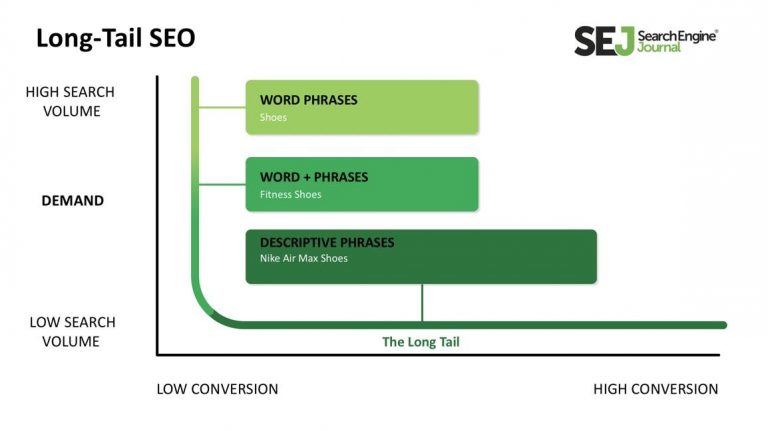Long-tail keywords play a crucial role in a content strategy by helping websites attract relevant traffic and reach a more targeted audience. These longer, more specific keyword phrases allow businesses to connect with users who are closer to making a purchase decision and are looking for specific information. In this article, we will explore the significance of long-tail keywords in content marketing, how they can improve search engine optimization efforts, and provide insights on how to effectively incorporate them into your content strategy.
Introduction to Long-Tail Keywords
Long-tail keywords are specific and niche search terms that users commonly use when they are closer to making a purchase or seeking a particular solution. These keywords typically comprise three or more words and are more detailed than generic, shorter keywords. Understanding how long-tail keywords work and incorporating them into your content strategy can significantly impact your website’s visibility and increase the quality of traffic you attract.
Why are Long-Tail Keywords Important?
- Higher Conversion Rates: Long-tail keywords target specific user intent, making it more likely for visitors to convert into customers or leads.
- Less Competition: Niche-specific long-tail keywords have lower competition compared to broader keywords, making it easier to rank for them.
- Increased Visibility: By focusing on long-tail keywords, you can attract highly targeted traffic interested in your specific offerings.
- Enhanced Relevance: Using long-tail keywords allows you to create content that directly addresses the needs and queries of your target audience.
How to Find Long-Tail Keywords
- Keyword Research Tools: Utilize tools like SEMrush, Ahrefs, or Google Keyword Planner to identify long-tail keywords related to your industry.
- Google Autocomplete: Start typing a broad keyword into the Google search bar and observe the suggestions that Google offers. These can be potential long-tail keywords.
- Related Searches: Scroll to the bottom of the Google search results page to find related search terms that may include long-tail keywords.
- Analyze Your Website Analytics: Look at the search terms that are already bringing users to your site to identify potential long-tail keywords you may be missing.
Incorporating Long-Tail Keywords in Content Strategy
- Optimize Titles and Headings: Use long-tail keywords in titles and headings to improve SEO and attract relevant traffic.
- Create Specific Landing Pages: Develop landing pages around specific long-tail keywords to provide targeted information to visitors.
- Write In-Depth Content: Long-tail keywords often signify user intent for detailed information. Create comprehensive content that fully addresses the topic.
-
Monitor and Adjust: Regularly review performance data to see how well your long-tail keywords are performing and make adjustments as needed.
What are Long-Tail Keywords?
Long-tail keywords are specific search phrases that search engine users type in when they are looking for very particular information. Unlike popular, broader keywords, long-tail keywords are more precise and typically consist of three or more words. Due to their precise nature, long-tail keywords usually have lower search volume compared to shorter, more general keywords. However, they are highly targeted, making them valuable for content strategy and SEO efforts.
Characteristics of Long-Tail Keywords
-
Specificity: Long-tail keywords are highly specific and target a niche audience looking for detailed information on a particular topic.
-
Less Competition: Long-tail keywords tend to have less competition than generic keywords, making it easier for websites to rank for them.
-
Intent-driven: Users who search using long-tail keywords often have a clear intention or purpose in mind, meaning they are more likely to convert into customers.
-
Higher Conversions: Due to their specificity and intent-driven nature, long-tail keywords have a higher conversion rate compared to broad keywords.
Importance of Long-Tail Keywords in Content Strategy
-
Relevance: Long-tail keywords help content creators tailor their content to match the specific queries of their target audience, leading to more relevant and useful content.
-
Increased Visibility: While long-tail keywords may have lower search volume individually, when collectively targeted, they can increase a website’s overall visibility in search engine results pages (SERPs).
-
Better Ranking Opportunities: Ranking for long-tail keywords is generally less competitive than ranking for broad keywords, providing websites with better chances to rank higher in search results.
-
Targeted Traffic: Long-tail keywords attract more targeted traffic to a website, as they are more likely to match the search intent of users looking for specific information or products.
In conclusion, long-tail keywords play a crucial role in content strategy by helping websites attract relevant traffic, improve their search engine ranking, and ultimately drive conversions. By incorporating long-tail keywords into their content, businesses can better align their offerings with the needs and preferences of their target audience.
Importance of Long-Tail Keywords in Content Strategy
Long-tail keywords play a crucial role in content strategy for several reasons:
-
Better Targeting: Long-tail keywords are more specific and usually have lower search volumes compared to broad keywords. However, they often convert better because they are more targeted towards the searcher’s intent. By incorporating long-tail keywords into your content strategy, you can attract highly relevant traffic that is more likely to convert into leads or customers.
-
Less Competition: Long-tail keywords usually have less competition than broad keywords, making it easier to rank higher in search engine results pages (SERPs). Focusing on long-tail keywords allows you to target niche audiences and stand out from competitors who may be competing for more generic terms.
-
Improved SEO Performance: Long-tail keywords help improve your website’s overall SEO performance by targeting specific search queries. Search engines like Google prioritize sites that provide relevant and high-quality content tailored to user intent. By including long-tail keywords in your content, you can increase your chances of ranking for specific search queries and driving organic traffic to your site.
-
Higher Conversion Rates: Long-tail keywords often indicate a more advanced stage in the buyer’s journey, where the searcher is closer to making a purchase decision. By targeting long-tail keywords that reflect user intent and preferences, you can create content that resonates with your target audience and drives higher conversion rates.
-
Enhanced User Experience: By incorporating long-tail keywords naturally into your content, you can provide a better user experience for your website visitors. Users who find content that directly addresses their specific queries are more likely to engage with your site, stay longer, and potentially convert into customers.
-
Content Personalization: Long-tail keywords can help you personalize your content to better meet the needs of your target audience. By understanding the specific needs and preferences of users searching for these long-tail terms, you can create customized content that addresses their concerns and positions your brand as a valuable resource.
Overall, incorporating long-tail keywords into your content strategy is essential for improving targeting, increasing visibility, driving conversions, and enhancing the overall user experience on your website. By understanding the importance of long-tail keywords in content strategy, you can create more effective and engaging content that resonates with your target audience.
How to Identify and Research Long-Tail Keywords
-
Use Keyword Research Tools: Utilize tools such as Google Keyword Planner, SEMrush, Ahrefs, or Moz Keyword Explorer to discover potential long-tail keywords related to your niche.
-
Analyze Competitor Keywords: Study the keywords your competitors are targeting to identify potential long-tail keyword opportunities that they may have missed.
-
Brainstorm Relevant Topics: Think about specific questions or topics related to your niche that users may search for. Consider using tools like Answer the Public or Quora to find common queries.
-
Look for Search Trends: Keep an eye on current trends and industry updates that could lead to the emergence of new long-tail keywords.
-
Utilize Google Autocomplete and Related Searches: Start typing relevant keywords into Google search and see the autocomplete suggestions and related searches at the bottom of the page for long-tail keyword ideas.
-
Check Google Search Console: Review the Search Query report in Google Search Console to see the search terms users are already using to find your site. Look for potential long-tail keywords in this data.
-
Use Long-Tail Keyword Generators: Tools like Ubersuggest, KW Finder, or Long Tail Pro can help generate long-tail keyword variations based on a seed keyword.
-
Consider User Intent: Ensure that the long-tail keywords you select align with the search intent of your target audience. Are they informational, navigational, or transactional queries?
-
Use Google Trends: Analyze Google Trends to see the popularity of certain keywords over time and identify potential long-tail keyword opportunities.
-
Consider Localized Keywords: If your business serves a specific geographic area, consider incorporating location-based long-tail keywords to attract local customers.
-
Optimize for Featured Snippets: Identify long-tail keywords that have a higher chance of appearing in featured snippets and optimize your content accordingly.
-
Use Surveys and Feedback: Collect feedback from customers, conduct surveys, or analyze social media interactions to identify common phrases or questions that could be turned into long-tail keywords.
By following these steps, you can effectively identify and research long-tail keywords that will enhance your content strategy and attract more targeted traffic to your website.
Incorporating Long-Tail Keywords into Content
When incorporating long-tail keywords into content, it is essential to follow a strategic approach that maximizes their potential impact on search engine rankings. Here are some effective techniques to seamlessly integrate long-tail keywords into your content:
-
Research relevant long-tail keywords: Begin the process by conducting thorough keyword research to identify specific long-tail keywords related to your niche or industry. Utilize tools like Google Keyword Planner, SEMrush, or Ahrefs to discover high-potential long-tail keywords that have low competition and high search volume.
-
Understand user intent: Analyze the intent behind the chosen long-tail keywords to create content that directly addresses the user’s query or problem. Tailor your content to provide valuable solutions or information that align with the searcher’s intent, enhancing the overall user experience.
-
Natural integration: Incorporate long-tail keywords organically throughout the content to avoid keyword stuffing, which can negatively impact readability and SEO. Integrate long-tail keywords into headings, subheadings, meta descriptions, image alt text, and naturally within the body of the content.
-
Create high-quality content: Develop informative, engaging, and well-researched content that not only includes long-tail keywords but also provides value to the target audience. Focus on creating content that is comprehensive, authoritative, and easy to understand, catering to the needs and preferences of your audience.
-
Optimize for search engines: Ensure that your content is optimized for search engines by including relevant long-tail keywords in meta tags, URLs, and image file names. Additionally, use internal linking to connect related content on your website, signaling to search engines the relevance and authority of your content.
-
Monitor performance: Regularly monitor the performance of your content using analytics tools to track keyword rankings, organic traffic, and user engagement. This data can help you assess the effectiveness of your long-tail keyword strategy and make necessary adjustments to optimize results.
By following these techniques, you can effectively incorporate long-tail keywords into your content strategy, enhancing visibility, attracting targeted traffic, and improving overall SEO performance.
Measuring the Impact of Long-Tail Keywords
When it comes to measuring the impact of long-tail keywords as part of a content strategy, there are several key metrics and tools that can be utilized to evaluate their effectiveness. Here are some ways to measure the impact of long-tail keywords:
1. Organic Traffic:
- One of the primary ways to measure the impact of long-tail keywords is through organic traffic. By using tools such as Google Analytics or SEMrush, you can track the amount of organic traffic your website receives from these specific long-tail keyword searches. An increase in organic traffic for these keywords indicates their effectiveness.
2. Click-Through Rate (CTR):
- Another important metric to consider when measuring the impact of long-tail keywords is the click-through rate. By analyzing the CTR of your long-tail keywords, you can determine how well they are attracting clicks from users. A high CTR suggests that your long-tail keywords are relevant and engaging for your target audience.
3. Conversion Rate:
- Tracking the conversion rate of visitors who come to your website through long-tail keyword searches is crucial to understanding their impact on your business goals. By using tools like Google Analytics or HubSpot, you can monitor how many of these visitors are converting into leads, customers, or other desired actions on your site.
4. Keyword Ranking:
- Monitoring the ranking of your long-tail keywords in search engine results pages (SERPs) is essential for assessing their impact. Tools like Ahrefs or Moz can help you track the positions of your keywords over time and determine if they are improving or declining in visibility.
5. Engagement Metrics:
- Analyzing engagement metrics such as bounce rate, time on page, and pages per session for visitors coming from long-tail keyword searches can provide insights into the quality of the traffic generated by these keywords. High engagement metrics indicate that your content is resonating with users who find your site through long-tail searches.
By using these various metrics and tools to measure the impact of long-tail keywords in your content strategy, you can gain valuable insights into their effectiveness in driving organic traffic, attracting clicks, and ultimately achieving your business goals.
Best Practices for Using Long-Tail Keywords in Content Strategy
-
Understand Your Audience: Before selecting long-tail keywords, it is essential to thoroughly understand your target audience. Identify their needs, preferences, and pain points to tailor your content strategy accordingly.
-
Conduct Keyword Research: Utilize keyword research tools to identify long-tail keywords that are relevant to your industry and have moderate search volume. Look for keywords that have low competition to increase your chances of ranking higher in search engine results.
-
Integrate Keywords Naturally: Once you have identified relevant long-tail keywords, integrate them naturally into your content. Avoid keyword stuffing, as this can negatively impact the readability and overall quality of your content.
-
Create High-Quality Content: Focus on creating high-quality, engaging content that provides value to your audience. Long-tail keywords should complement your content and enhance its relevance, rather than be the sole focus.
-
Optimize Meta Data: Optimize your meta titles, meta descriptions, and URLs with long-tail keywords to improve your website’s chances of ranking in search engine results. Make sure the keywords are relevant to the content on the page.
-
Use Long-Tail Keywords in Headings: Incorporate long-tail keywords into your headings and subheadings to make it easier for search engines to understand the context of your content. This will also improve the overall user experience.
-
Track and Analyze Performance: Regularly track and analyze the performance of your content using tools like Google Analytics. Monitor how your chosen long-tail keywords are performing in terms of traffic, conversions, and rankings.
-
Update and Refresh Content: Periodically update and refresh your content to stay relevant and maintain its search engine rankings. Consider revisiting your long-tail keyword strategy to ensure it aligns with current trends and audience preferences.
-
Stay Current with SEO Trends: Keep abreast of the latest SEO trends and best practices to continually refine and optimize your long-tail keyword strategy. Staying informed will help you adapt to changes in search engine algorithms and remain competitive in search results.
By following these best practices for using long-tail keywords in your content strategy, you can enhance the visibility, relevance, and overall performance of your content in search engine results, ultimately driving more organic traffic to your website.
Conclusion
In conclusion, long-tail keywords play a crucial role in content strategy as they help target specific and niche audiences, improve search engine rankings, and drive organic traffic to websites. By understanding what long-tail keywords are and how to identify and research them effectively, content creators can incorporate these keywords into their content to improve visibility and engagement. Measuring the impact of long-tail keywords through analytics is essential to refining content strategies and maximizing results. Following best practices for using long-tail keywords, such as optimizing for user intent and relevance, can lead to better overall SEO performance and a stronger online presence. Overall, incorporating long-tail keywords into content strategy can greatly enhance a website’s visibility and reach, making it a valuable tool for digital marketing success.
If you’re looking to improve your content strategy, consider the role of long-tail keywords. These specific keyword phrases can help drive targeted traffic to your website and increase your chances of ranking higher in search engine results. To learn more about incorporating long-tail keywords into your content strategy, visit DeltaWriter.com for valuable insights and resources.

Director @Anyalpha, a Top Software Development Company offering Mobile App Development and Website Development Services to Businesses & Startups.



